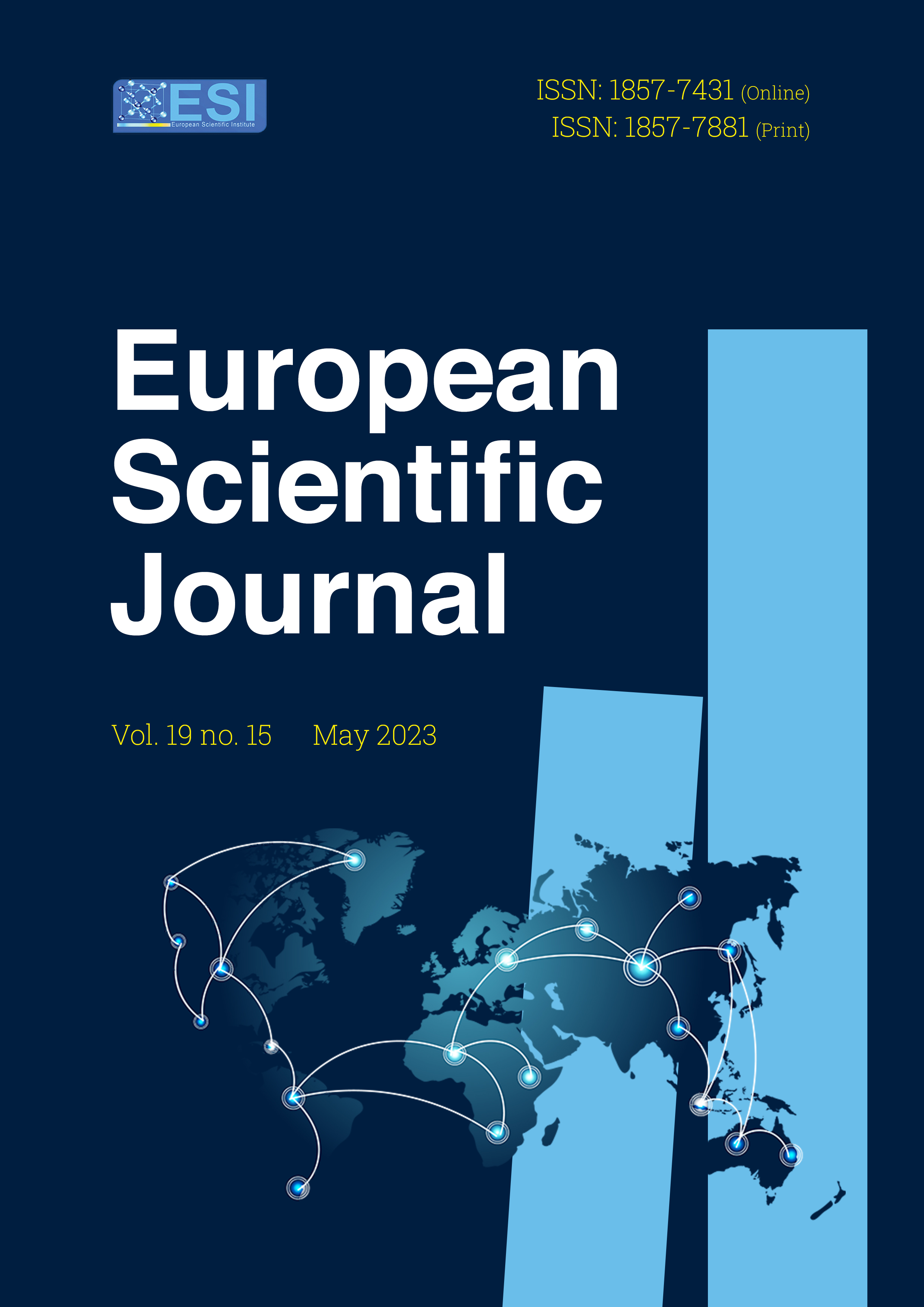The Effects of Ripening Stage and Mode of Culture of Chemlali, Arbequina, and Koroneiki on the Capacities of Oils to Scavenge ABTS Free Radicals
Abstract
This paper focuses on evaluating the antioxidant power of olive oil against the cation radical ABTS•+ according to cultivars (Chemlali, Arbequina and Koroneiki), culture modes (extensive and intensive), ripening stages (November and December corresponding stages), and study year (2017 and 2018). Radical percentage inhibition (PI), Trolox equivalent antioxidant capacity (TEAC), inhibitory concentration required to scavenge 50% of radicals (IC50), and principal component analysis (PCA) were determined. The oil of the Tunisian main cultivar, Chemlali, cultivated in extensive mode, has the best scavenging power with the lowest IC50 values of 9.3, 10.8, 9.65 and 10.4 µg/ml respectively in all the ripening stages. Also, at the lowest tested concentration of 20 µg/ml, this oil has the highest TEAC values, respectively 2.28 and 2.20 in November of 2017 and 2018. For the introduced cultivars, Koroneiki presents better performance than Arbequina, in intensive mode, with IC50 ranged from 9.6 to 13.8 against 12.40 to 22.35 for Arbequina. Furthermore, the principal component analysis proves that the oils of Chemlali in extensive mode and Koroneiki in intensive mode have the best scavenging capacity of ABTS•+. This study proves that the extensive mode is the best culture mode and the ripening stage of November is the best stage in order to get oils with the highest antioxidant capacity.
Downloads
Metrics
PlumX Statistics
References
2. Aissaoui, R. (2009). Les défis à l’exportation de l’huile d’olive en Tunisie. Institut supérieur de gestion de Sousse – Tunisie – Maîtrise en commerce international
3. Ajana, H., El Antari, A., & Hafidi, A. (1999). Evolution of biométrie parameters and chemical composition of olives from the Moroccan Picholine variety during fruit ripeness. Grasas y Aceites, 50(1), 1-6. https://doi.org/10.3989/gya.1999.v50.i1.628
4. Amiot, M. J., Fleuriet, A., & Macheix, J. J. (1989). Accumulation of oleuropein derivatives during olive maturation. Phytochemistry, 28(1), 67-69. https://doi.org/10.1016/0031-9422(89)85009-5
5. Aparicio, R., Roda, L., Albi, M. A., & Gutiérrez, F. (1999). Effect of various compounds on virgin olive oil stability measured by Rancimat. Journal Of Agricultural and Food Chemistry, 47(10), 4150-4155. https://doi.org/10.1021/jf9812230
6. Arnao, M. B., Cano, A., & Acosta, M. (2001). The hydrophilic and lipophilic contribution to total antioxidant activity. Food chemistry, 73(2), 239-244. https://doi.org/10.1016/S0308-8146(00)00324-1
7. Bayram, B., Esatbeyoglu, T., Schulze, N., Ozcelik, B., Frank, J., & Rimbach, G. (2012). Comprehensive analysis of polyphenols in 55 extra virgin olive oils by HPLC-ECD and their correlation with antioxidant activities. Plant Foods for Human Nutrition, 67(4), 326-336. https://DOI 10.1007/s11130-012-0315-z
8. Boskou, D., Blekas, G., & Tsimidou, M. (1996). Olive oil. Chemistry and Technology. Champaign, IL: AOCS.
9. Bouaziz, M., Chamkha, M., & Sayadi, S. (2004). Comparative study on phenolic content and antioxidant activity during maturation of the olive cultivar Chemlali from Tunisia. Journal of Agricultural and Food Chemistry, 52(17), 5476-5481. https://doi.org/10.1021/jf0497004
10. Bubonja-Sonje, M., Giacometti, J., & Abram, M. (2011). Antioxidant and antilisterial activity of olive oil, cocoa and rosemary extract polyphenols. Food Chemistry, 127(4), 1821-1827. https://doi.org/10.1016/j.foodchem.2011.02.071
11. Covas, M.I. (2007). Olive oil and the cardiovascular system. Pharmacological Research, 55(3), 175-186. https://doi.org/10.1016/j.phrs.2007.01.010
12. Dabbou, S., Brahmi, F., Taamali, A., Issaoui, M., Ouni, Y., Braham, M., & Hammami, M. (2010). Extra virgin olive oil components and oxidative stability from olives grown in Tunisia. Journal of the American Oil Chemists' Society, 87(10), 1199-1209. https://doi.10.1007/s11746-010-1600-3
13. Dabbou, S., Issaoui, M., Servili, M., Taticchi, A., Sifi, S., Montedoro, G. F., & Hammami, M. (2009). Characterisation of virgin olive oils from European olive cultivars introduced in Tunisia. European Journal of Lipid Science and Technology, 111(4), 392 401. https://doi.org/10.1002/ejlt.200800032
14. El Antari, A., Hilali, A., Boulouha, B., El Moudni, A. (2000). Etude de l’influence de la variété, de l’environnement et des techniques culturales sur les caractéristiques des fruits et la composition de l’huile d’olive vierge extra au Maroc. Olivae, (80): 29-36.
15. Esti, M., Cinquanta, L., & La Notte, E. (1998). Phenolic compounds in different olive varieties. Journal of Agricultural and Food Chemistry, 46(1), 32-35. https://doi.org/10.1021/jf970391+
16. Feki, M., Hannachi, H., Ali, M. B., Hamrouni, H., Romano, E., Karray, B., & Hammami, M. (2013). Tunisian “Chemlali” oil variety registered designation of origins predicted by pomological characters, fatty acids composition and organoleptic analysis. British Food Journal. https://doi.org/10.1108/BFJ-Sep-2011-0235
17. Gutiérrez, F., & Fernández, J. L. (2002). Determinant parameters and components in the storage of virgin olive oil. Prediction of storage time beyond which the oil is no longer of “extra” quality. Journal of Agricultural and Food Chemistry, 50(3), 571-577. https://doi.org/10.1021/jf0102158
18. Jacotot, B. (1996). Huile d'olive et prévention. Nutrition clinique et métabolisme, 10(4), 7S-9S. https://doi.org/10.1016/S0985-0562(96)80064-1
19. Matos, L. C., Cunha, S. C., Amaral, J. S., Pereira, J. A., Andrade, P. B., Seabra, R. M., & Oliveira, B. P. (2007). Chemometric characterization of three varietal olive oils (Cvs. Cobrançosa, Madural and Verdeal Transmontana) extracted from olives with different maturation indices. Food Chemistry, 102(1), 406-414. https://doi.org/10.1016/j.foodchem.2005.12.031
20. Omar, S. H. (2010). Oleuropein in olive and its pharmacological effects. Scientia pharmaceutica, 78(2), 133-154. https://doi.org/10.3797/scipharm.0912-18
21. Salvador, M. D., Aranda, F., & Fregapane, G. (2001). Influence of fruit ripening on ‘Cornicabra’virgin olive oil quality a study of four successive crop seasons. Food Chemistry, 73(1), 45-53. https://doi.org/10.1016/S0308-8146(00)00276-4
22. Stefano, G. D., Piacquadio, P., Servili, M., Giovacchino, L. D., & Sciancalepore, V. (1999). Effect of extraction systems on the phenolic composition of virgin olive oils. Lipid/Fett, 101(9), 328-332. https://doi.org/10.1002/(SICI)1521-4133(199909)101:9<328::AID-LIPI328>3.0.CO;2-M
23. Usanmaz, S., Kahramanoğlu, İ. B. R. A. H. I. M., Alas, T., & Okatan, V. O. L. K. A. N. (2019). Performance and oil quality of seven olive cultivars under high density planting system in northern Cyprus. Pakistan Journal of Botany, 51(5), 1775-1781. http://dx.doi.org/10.30848/PJB2019-5(42)
24. Visioli, F., Romani, A., Mulinacci, N., Zarini, S., Conte, D., Vincieri, F. F., & Galli, C. (1999). Antioxidant and other biological activities of olive mill waste waters. Journal of Agricultural and Food Chemistry, 47(8), 3397-3401.
Copyright (c) 2023 Mourad Jellali, Dhouha Saidana Naija, Samia Ben Mansour Guedde, Mohamed Braham

This work is licensed under a Creative Commons Attribution-NonCommercial-NoDerivatives 4.0 International License.








